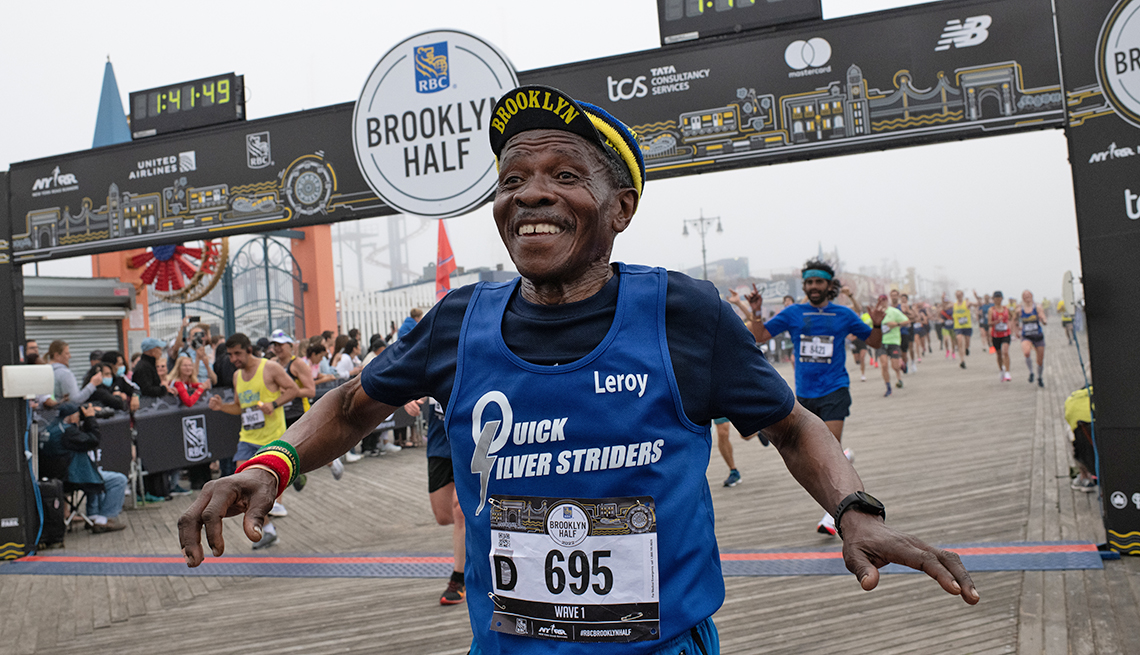
- Select a language for the TTS:
- UK English Female
- UK English Male
- US English Female
- US English Male
- Australian Female
- Australian Male
- Language selected: (auto detect) - EN
Play all audios:
It was two days before the Brooklyn Half Marathon, and Leroy Cummins had begun the morning as usual at 5 a.m., running for two hours around the borough’s East Flatbush section, where the
neighbors call him Marathon Man. “ ‘Look at this guy: He’s got gray hair and he’s only 5-foot-5, and he’s out there getting his exercise on,’ ” he says, laughing, as he imagines what they’re
saying to themselves when they give him a wave or a shout of support. Cummins, who is 72, ran his first marathon two years ago in an impressive 3:35. He would finish the Brooklyn Half in
1:47:02, or about 8 minutes a mile, to win his age group. But he’s far from reckless. He keeps whole cases of coconut water on hand to stay hydrated. He carbo-loads on his wife’s Rasta
pasta, tossed with Caribbean-style jerk chicken in a nod to their West Indian ancestry. He skips running two days a week in favor of strength and resistance training. And when he does run,
it’s sometimes comparatively slowly, with intervals of speed. “I call it base work,” Cummins says. “It’s not about time, initially. Fast times will come.” What’s more important after 50, he
says, is to avoid injury and muscle fatigue. Runners are rolling along later in life — and getting faster. That doesn’t mean everyone who wants to run after 50 needs to break a record.
Younger runners may be motivated by having something to prove; older runners are already proving something just by being out there. But they also need to be mindful of inevitable physical
changes that require more attention to stretching, form, intensity, hydration and nutrition. Consulting a physician to make sure there aren’t medical risks is also a wise move. When
planning to run a road or trail race, older runners need to start training earlier than they used to. That’s because they need more recovery days than younger runners do. And when something
hurts, they need to give it time to rest. “You’re never too old to learn new things,” says the irrepressible Cummins. “You just have to be smart about it.” Here are eight key training tips
to keep you healthy and happy as you build up the miles. 1. MANAGE EXPECTATIONS Among other things, aging brings a decline in V02 max levels — the amount of oxygen available during
exercise, which can fall as much as 10 percent per decade — and in maximum heart rate. Runners lose about 1 percent of their speed per year after 40, and 2 to 3 percent after age 70, studies
show. So older runners need to start their runs at a slower pace and build up to a faster one as they feel comfortable. “As we get older, we may not realize that we have certain limitations
we’re not used to,” says Sachin Narain, an interventional pain physician at The Pain Center of Arizona and a former distance runner. “Don’t push those limits as you might have when you were
25 or 35.” Ben Navarrete is a coach for Striders, a free walking and fitness program for older adults. New York Road Runners Some people want to go from zero to 60 overnight, and
immediately run a marathon, observes Ben Navarrete, a coach for the Striders free walking and fitness program for older adults, run by New York City Marathon parent New York Road Runners. “I
start off telling people that they need to first accept the fact that they are getting a little older,” says Navarrete, who is 74. “It doesn’t mean you can’t still run fast, but you may not
be able to run as fast as you did a few years ago.” That means spending more time building a base of endurance at a slower pace. “Half of your training should be base building,” Navarrete
says.


